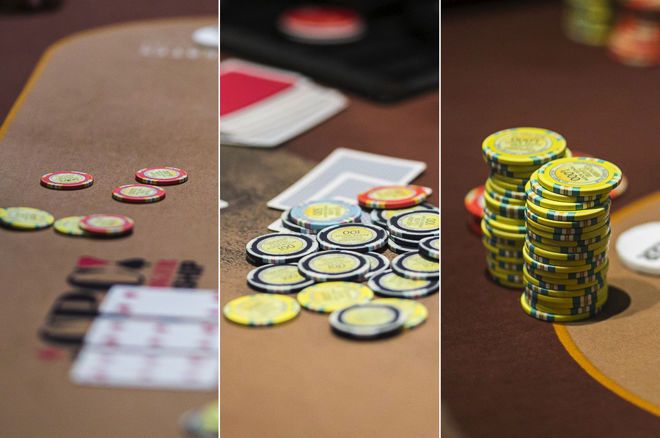
Like all of my stabilizers, this one was born from necessity. My problem at no-limit was big pots. They were too important. Pumped up pots gave me a thumped up heart, which somehow blurred my vision. If I got coolered a couple times and I booked a losing session, I could always blame my poor results on the cards, no matter how bad I played.
My session results are often determined by just a few big pots.
True, but delusional. Those words did nothing but feed my need for action. They reeked of resignation: a dismissal of responsibility. I’d run bad and dip into despondency and play too many big pots and play lazy on the small ones because what’s the point, really, since…
My fate is sealed.
The three-stakes-in-one idea − which I’ll explain at the end − sped me along the path to my current view, which is this:
Big pots are bigger than medium pots which are bigger than small pots. Whoopity whatever. To make the most money possible, I must play awesomely always. Every pot deserves my attention and reverence. Every pot is sacred.
Let’s say I get pocket aces and I limp. My plan is to 3-bet preflop should the opportunity arise. At the moment I choose to limp, I’ve split my future in two. The pot will be small if no one raises, or big if someone does. Pre-acceptance of both paths allows me to feel no excitement if I get to 3-bet, and no disappointment if I don’t. Then I can play fluidly no matter what happens, undisturbed by expectations.
Let’s beam back to the 90s, before no-limit caught fire. I was playing 50 hours a week. Almost all of it was $15/30, $20/40, $30/60, and $40/80 limit hold’em. Let’s lump those together and call them “high stakes.” Those were the stakes that paid the bills.
Sometimes when I was waiting for a high-stakes seat I would play $3/6 limit hold’em, rather than sit idly by. Let’s call $3/6 “low stakes.”
This was a three-part revelation…
Day one: I played some sloppy $3/6 for an hour and sloughed off two hundred. Then I played sloppy $40/80 for an hour and blew two grand. Through the frustration I saw that my lackadaisical mindset had carried over from $3/6 to $40/80.
Next day, in the $3/6 game: I raised before the flop with Q-T suited under the gun − a play that has lax written all over it.
Same day, in the $20/40 game: I got Q-T suited under the gun and folded, as I had done every time with that hand in that situation at high stakes for at least ten years.
And that’s when the epiphany punted me. At once I was happy and sad. Sad because I wanted to redo my entire poker life. Happy because everything was going to be better now.
For five minutes, during the $20/40 game, I had X-ray vision. I could see through the delusion. At high-stakes, I always mucked Q-T in that spot. At low stakes, I’d been selling a story to my bloated self…
I’m the best player at the table. I can get away with playing hands I shouldn’t. I’m not actually losing money. I’m just giving up a fraction of my enormous edge. Plus, I was suited.
Right after I mucked the queen-ten of hearts in the $20/40 game, I pulled out my paper and pen…
When I play $3/6 before $20/40, it’s one or the other. I’m either taking the game seriously or I’m fucking around. I’m either practicing sloppy or practicing solid, always.
And that was that. My relationship to low stakes changed forever. My new objective was to settle into the timeless folding mindset at $3/6, even though the stakes were relatively inconsequential and the opponents were softer.
If I can fold it there
I’ll fold it anywhere
It’s up to me
Low stakes became rehearsal for high stakes. The effect on my earn rate was sudden and permanent. But my psyche took a hit. I kept thinking about how much money I’d have if I’d been doing this all along. Ah well, not the first or last time that regret followed reform.
Years went by. No-limit became the game of choice. More years passed. Then, during a poker game, I had an un-deluded moment, and I saw that I cared too much about big pots and not enough about small pots.
Big pots were bad because they made me over-rate and under-rate everything. And they provoked the tilt demon. Big pots powered the roller coaster.
Small pots, I realized, were a big problem too. Because that’s where they creep in. The sneaky, seepy leaks. A button limp here. A small-blind completion there. So passive, so innocent, these stepping stones to hell.
My mindscape needed some leveling, and I had just the tool. But first, I’d need to refit it for this job.
- Limped pots = low stakes
- Single-raise pots = mid stakes
- Three-bet pots = high stakes
I just needed to think of small pots as low stakes, and repeat “all stakes are sacred” ten times every pee break.
And poof. In the same way that I had committed to playing all stakes optimally at limit hold’em, I committed to playing all no-limit pots with a level temperament and loyal focus.
Today, the big pots no longer linger longer than the small pots. It’s all the same forgettable sauce.
As my clients discover, less pain and more money go together. Coaching by Tommy
